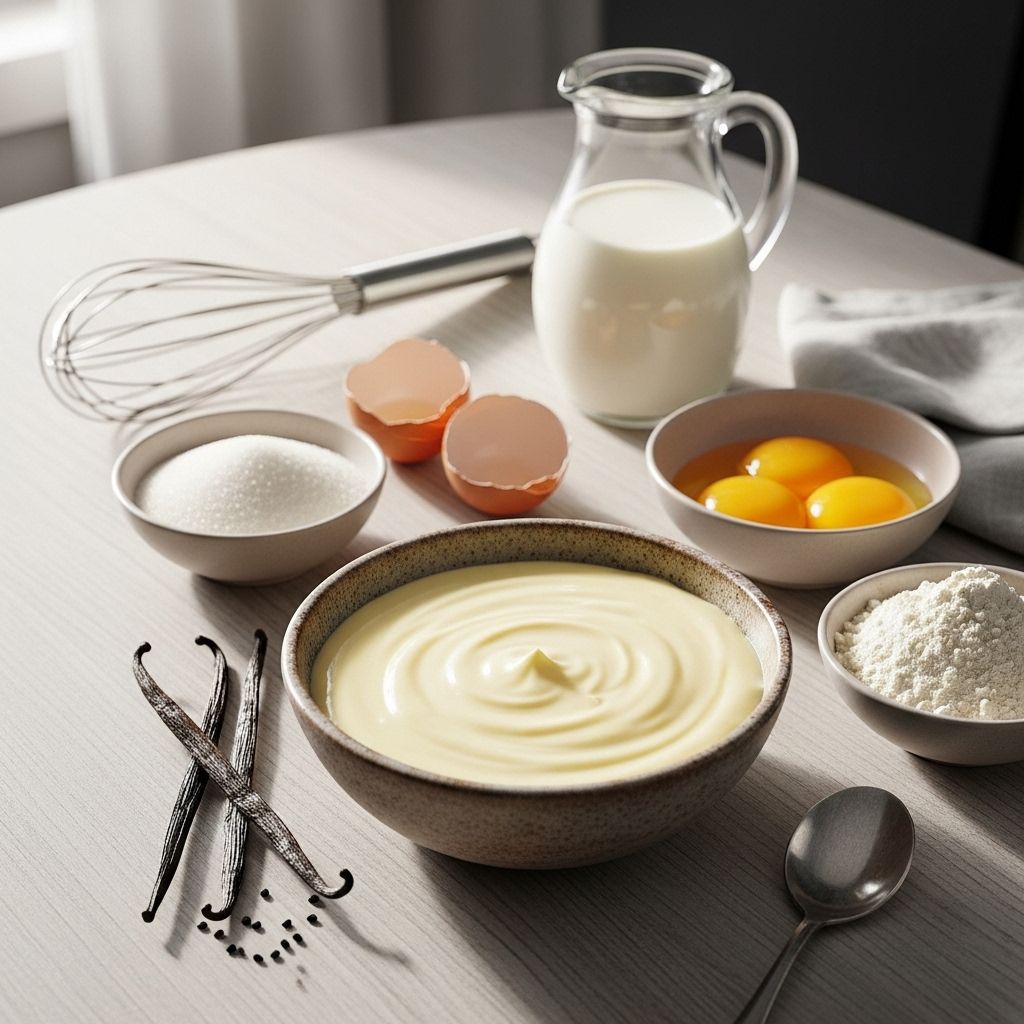Vanilla Pastry Cream: 6 Essential Steps For Perfect Custard
Gentle whisking and precise heat yield an irresistibly silky, lump-free custard base.

Vanilla Pastry Cream (Crème Pâtissière): A Comprehensive Guide
Vanilla pastry cream, more formally known as crème pâtissière, stands at the heart of classic French pastry. It is the luscious, rich, and silky custard found in éclairs, fruit tarts, Boston cream pie, mille-feuille, and countless other desserts. Achieving a flawless pastry cream requires understanding the science, choosing the right ingredients, and mastering the step-by-step method for the perfect result.
What Is Pastry Cream?
Pastry cream (crème pâtissière) is a classic French custard made by cooking a mixture of milk, eggs, sugar, starch (usually cornstarch), butter, and flavorings—most commonly vanilla. Unlike pourable custards (such as crème anglaise), pastry cream is thick enough to hold its shape, making it ideal for filling, piping, and layering baked goods.
- Texture: Thick, creamy, and smooth. Not pourable like a sauce, but not rubbery like gelatin desserts.
- Flavors: Most often vanilla, but variations can include chocolate, coffee, citrus, or other infusions.
- Primary Uses: Éclairs, cream puffs, fruit tarts, cakes (such as Boston cream pie), and as a base for other desserts.
Ingredients: Quality Matters
The flavor and texture of pastry cream depend on a handful of key ingredients. Choosing high-quality supplies and understanding their roles is critical for success:
- Milk: Whole milk (2 cups; approx. 480 g) is essential for a creamy, rich mouthfeel. Some bakers mix in a little heavy cream for extra richness, but using all milk keeps the cream light and silky.
- Vanilla: Infusing the milk with vanilla beans gives unparalleled flavor and aroma. Both Tahitian and Madagascar beans work well; scraped seeds and pod included. Alternatively, use vanilla bean paste (2 tsp), or as a last resort, pure vanilla extract (about 4 tsp).
- Egg Yolks: Six large egg yolks (preferably at room temperature) provide color, richness, and body. They are responsible for thickening the cream when cooked.
- Sugar: About 3/4 cup (150 g) granulated sugar sweetens and helps stabilize the eggs during cooking.
- Cornstarch: The thickener. 6 tbsp (45 g) cornstarch keeps the cream firm enough to hold its shape but not stiff. For particularly firm fillings (e.g., pie layers), increase to 7 tbsp (52 g).
- Butter: 1/2 stick (55 g) unsalted butter, cubed and cold. Stirred in at the end for a glossy, creamy finish, enhanced flavor, and added richness.
Optional: A pinch of salt can sharpen flavors. Other infusions—such as citrus peel or instant espresso—may be added alongside or instead of vanilla for variation.
Equipment You’ll Need
- 2-quart saucepan or saucier: Stainless steel recommended for even heat and easy stirring.
- Balloon whisk: For vigorous stirring, critical during tempering and thickening.
- Fine-mesh strainer: To ensure perfect smoothness by removing any lumps.
- Heatproof spatula: For scraping the pan and stirring in the butter.
- Bowl and plastic wrap: For chilling pastry cream quickly and preventing a skin from forming.
Step-by-Step: How to Make Vanilla Pastry Cream
- Infuse the Milk:
Combine whole milk and the scraped seeds plus pod of a vanilla bean (or bean paste/extract) in your saucepan. Bring slowly to a bare simmer—do not let it boil. Remove from heat, cover, and steep for 30 minutes to draw out the vanilla’s full flavor. This step is crucial for intensity and subtlety in the finished custard.
After perfecting your vanilla pastry cream, explore how flavors can transform a classic dessert with our deep dive into silky-smooth stovetop butterscotch pudding. This rich dessert will tantalize your taste buds and expand your culinary toolkit. - Prepare the Egg Mixture:
In a medium bowl, vigorously whisk the egg yolks and sugar until pale and thick. Sift in the cornstarch and whisk until smooth and creamy. Ensure all lumps are gone—the starch prevents eggs from scrambling later and ensures a unified custard texture.
- Temper the Mixture:
While whisking continuously, slowly pour about one-third of the hot milk into the yolk mixture. This tempers the eggs—raising their temperature gradually to prevent curdling. Pour the entire egg–milk mixture back into the saucepan, whisking constantly.
- Cook the Custard:
Set the saucepan over medium heat. Whisk the mixture constantly (especially in the corners of the pan). As it heats, pastry cream will thicken noticeably. When it bubbles (about 2–3 minutes), cook for 1 additional minute to fully gelatinize the starch and neutralize raw flavors.
- Finish with Butter:
Remove the pan from heat. Immediately whisk in cold, cubed unsalted butter until melted and fully incorporated—this boosts richness and gloss.
- Strain and Chill:
Pour the hot pastry cream through a fine-mesh strainer into a clean bowl to remove any lumps and the vanilla bean pod. Press plastic wrap directly onto the surface of the cream. Let cool for 10–15 minutes at room temperature, then refrigerate at least 2 hours, preferably overnight. The cream will firm further as it chills.
Pastry Cream: Tips and Troubleshooting
- Lumpy Cream? Strain it while hot through a fine-mesh sieve; it will smooth out most imperfections.
- Too Thick or Firm? Gently whisk in a little cold milk, one tablespoon at a time, until desired consistency is reached.
- Too Loose? You may need to cook it a little longer next time. For now, you can try returning to low heat, whisking constantly, until thickened, being careful not to overcook.
- Skin Formation? Always press plastic wrap directly on the surface of the pastry cream as it chills. This prevents a dry skin from forming.
- Curdled or Scrambled? Curdling occurs if the eggs cook too quickly. Straining helps, but next time, temper eggs more cautiously and use gentle, even heat.
Storage and Make-Ahead
- Refrigeration: Store pastry cream in an airtight container with plastic wrap pressed directly onto the surface. It stays fresh in the fridge for up to three days.
- Freezing: Not recommended—freezing disrupts the structure, causing curdling after thawing.
- Re-whisking: Before use, stir the chilled cream well to restore its silky texture.
Serving Suggestions and Classic Uses
- Éclairs and Profiteroles: Pipe pastry cream into baked pâte à choux shells and glaze with chocolate.
- Fruit Tarts: Spread cooled cream in a tart shell; top with fresh berries and a clear glaze.
- Mille-Feuille (Napoleon): Layer crisp puff pastry with pastry cream and finish with powdered sugar or fondant.
- Boston Cream Pie: Use as a cake filling between layers, topped with chocolate ganache.
- Crème Légère: Fold whipped cream into pastry cream for a lighter, mousse-like filling.
Variations and Customization
- Chocolate Pastry Cream: Whisk in melted bittersweet or semisweet chocolate after the custard is cooked.
- Coffee Pastry Cream: Dissolve instant espresso into the milk or infuse with coffee beans before cooking.
- Citrus Pastry Cream: Add strips of lemon or orange zest to the milk while it heats, then strain out before combining with eggs.
- Almond or Hazelnut Cream: Blend in a spoonful of nut paste at the end for a robust, aromatic twist.
Frequently Asked Questions (FAQs)
What makes pastry cream different from other custards?
Pastry cream is thickened with both eggs and starch (usually cornstarch), resulting in a custard that is much firmer and more stable than pourable custards like crème anglaise. This makes it ideal for filling, piping, and baking into other desserts.
Can I use pastry cream for baking inside pastries?
Yes. Pastry cream can be baked inside doughs like Danish or brioche, though it will set more firmly after baking. For best results, ensure the cream is thick enough and not overly runny before using.
How do I prevent my pastry cream from separating?
Proper tempering of eggs, constant whisking, and cooking over moderate heat ensure a smooth, unified cream. Adding butter off-heat and immediately cooling with plastic wrap on the surface helps prevent separation.
Is it safe to make pastry cream ahead of time?
Absolutely. Store it well-covered in the refrigerator for up to three days. Before using, whisk it smooth and check for any off odors, which indicate spoilage.
Do I need to use a vanilla bean, or can I substitute extract?
While vanilla beans provide superior flavor and aroma (with characteristic specks in the finished cream), high-quality vanilla extract or paste may be substituted. Adjust the amount (use about twice the extract as you would paste or beans).
Helpful Tips for Perfect Pastry Cream Every Time
- Steep your vanilla: Allowing the pod to steep in hot milk maximizes flavor complexity and aroma.
- Whisk constantly: Prevents lumps and avoids scorching as the custard thickens.
- Watch the heat: Do not let the mixture boil forcefully, which can cause curdling. Gentle bubbles at the surface are enough.
- Strain while hot: This ensures perfect creaminess and removes any bits of cooked egg.
Recipe: Classic Vanilla Pastry Cream
| Ingredient | Amount |
|---|---|
| Whole milk | 2 cups (480 g) |
| Vanilla bean (or paste/extract) | 1 (or 2 tsp paste/4 tsp extract) |
| Egg yolks | 6 large |
| Granulated sugar | 3/4 cup (150 g) |
| Cornstarch | 6 tbsp (45 g) |
| Unsalted butter | 1/2 stick (55 g), cold, cubed |
| Salt (optional) | Pinch |
Special Equipment: 2-quart saucepan, whisk, fine-mesh strainer, heatproof spatula, cling film/plastic wrap.
Related Recipes
- Crème Légère: Lighten pastry cream by folding in whipped cream, excellent for fruit or cream pies.
- Diplomat Cream: Combine pastry cream and stabilized whipped cream for a mousse-like filling.
- Ganache-Topped Éclairs: Fill choux pastries with pastry cream and top with rich, glossy chocolate ganache.
Expert Tips for Making and Using Pastry Cream
- Always strain pastry cream while hot to ensure smoothness and remove the vanilla pod.
- Press plastic wrap directly onto the surface before chilling to prevent skin formation.
- Adjust cornstarch quantity for desired firmness—less for a softer cream, more for cake or slice filling.
- Pastry cream can be flavored with almost any extract, liqueur, or infusion for creative variations.
- Re-whisk refrigerated pastry cream until silky before use; if too firm, add cold milk a spoonful at a time.
References
Read full bio of Shinta












